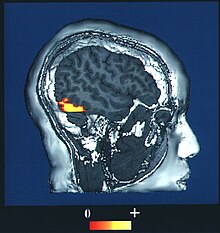 Global Information
Global InformationProsopagnosia information
| Prosopagnosia | |
|---|---|
| Other names | Face blindness |
 | |
| The fusiform face area, the part of the brain associated with facial recognition | |
| Pronunciation |
|
| Specialty | Neurology |
Prosopagnosia (from Greek prósōpon, meaning "face", and agnōsía, meaning "non-knowledge"),[2] also known as face blindness,[3] is a cognitive disorder of face perception in which the ability to recognize familiar faces, including one's own face (self-recognition), is impaired, while other aspects of visual processing (e.g. object discrimination) and intellectual functioning (e.g., decision-making) remain intact. The term originally referred to a condition following acute brain damage (acquired prosopagnosia), but a congenital or developmental form of the disorder also exists, with a prevalence of 2.5%.[4] The brain area usually associated with prosopagnosia is the fusiform gyrus,[5] which activates specifically in response to faces. The functionality of the fusiform gyrus allows most people to recognize faces in more detail than they do similarly complex inanimate objects. For those with prosopagnosia, the method for recognizing faces depends on the less sensitive object-recognition system. The right hemisphere fusiform gyrus is more often involved in familiar face recognition than the left. It remains unclear whether the fusiform gyrus is specific for the recognition of human faces or if it is also involved in highly trained visual stimuli. Prosopoagnosic patients are under normal conditions able to recognize facial expressions and emotions.[6][7]
Acquired prosopagnosia results from occipito-temporal lobe damage and is most often found in adults. It is subdivided into apperceptive and associative prosopagnosia. In congenital prosopagnosia, the individual never adequately develops the ability to recognize faces.[8]
Though there have been several attempts at remediation, no therapies have demonstrated lasting improvements across a group of prosopagnosics. Prosopagnosics often learn to use "piecemeal" or "feature-by-feature" recognition strategies. This may involve secondary clues such as clothing, gait, hair color, skin color, body shape, and voice.[9] Because the face seems to function as an important identifying feature in memory, it can also be difficult for people with this condition to keep track of information about people, and socialize normally with others. Prosopagnosia has also been associated with other disorders that are associated with nearby brain areas: left hemianopsia (loss of vision from left side of space, associated with damage to the right occipital lobe), achromatopsia (a deficit in color perception often associated with unilateral or bilateral lesions in the temporo-occipital junction) and topographical disorientation (a loss of environmental familiarity and difficulties in using landmarks, associated with lesions in the posterior part of the parahippocampal gyrus and anterior part of the lingual gyrus of the right hemisphere).[10]
The opposite of prosopagnosia is the skill of superior face recognition ability. People with this ability are called "super recognizers".[11]
- ^ "Prosopagnosia". collinsdictionary.com.
- ^ Harper D. "Prosopoagnosia". Online Etymology Dictionary.
- ^ Davis J (November 2006). "Face Blind". Wired. Retrieved 31 December 2014. ("[Bill] Choisser had even begun to popularize a name for the condition: face blindness.")
- ^ Grüter T, Grüter M, Carbon CC (March 2008). "Neural and genetic foundations of face recognition and prosopagnosia". Journal of Neuropsychology. 2 (1): 79–97. CiteSeerX 10.1.1.571.9472. doi:10.1348/174866407X231001. PMID 19334306.
- ^ "Face blindness not just skin deep". CNN. Retrieved 19 November 2015.
- ^ de Gelder B, Frissen I, Barton J, Hadjikhani N (October 2003). "A modulatory role for facial expressions in prosopagnosia". Proceedings of the National Academy of Sciences of the United States of America. 100 (22): 13105–13110. Bibcode:2003PNAS..10013105D. doi:10.1073/pnas.1735530100. PMC 240752. PMID 14561892.
- ^ Tsantani M, Gray KL, Cook R (September 2022). "New evidence of impaired expression recognition in developmental prosopagnosia" (PDF). Cortex; A Journal Devoted to the Study of the Nervous System and Behavior. 154: 15–26. doi:10.1016/j.cortex.2022.05.008. PMID 35728295. S2CID 249159789.
- ^ Behrmann M, Avidan G (April 2005). "Congenital prosopagnosia: face-blind from birth". Trends in Cognitive Sciences. 9 (4): 180–187. CiteSeerX 10.1.1.379.4935. doi:10.1016/j.tics.2005.02.011. PMID 15808500. S2CID 12029388.
- ^ Dolan EW (31 January 2024). "Prosopagnosia: Mayo Clinic study sheds new light on "face blindness"". Psypost - Psychology News. Retrieved 4 February 2024.
- ^ Mayer E, Rossion B (2007). "Prosopagnosia" (PDF). In Godefroy O, Bogousslavsky J (eds.). The Behavioral and Cognitive Neurology of Stroke (1st ed.). New York: Cambridge University Press. pp. 315–334. doi:10.1017/CBO9780511544880.017. ISBN 978-0-521-84261-7. OCLC 468190971. Archived from the original (PDF) on 1 July 2013. Retrieved 19 December 2012.
- ^ Barry E (5 September 2018). "From Mountain of CCTV Footage, Pay Dirt: 2 Russians Are Named in Spy Poisoning". The New York Times. Retrieved 6 September 2018.